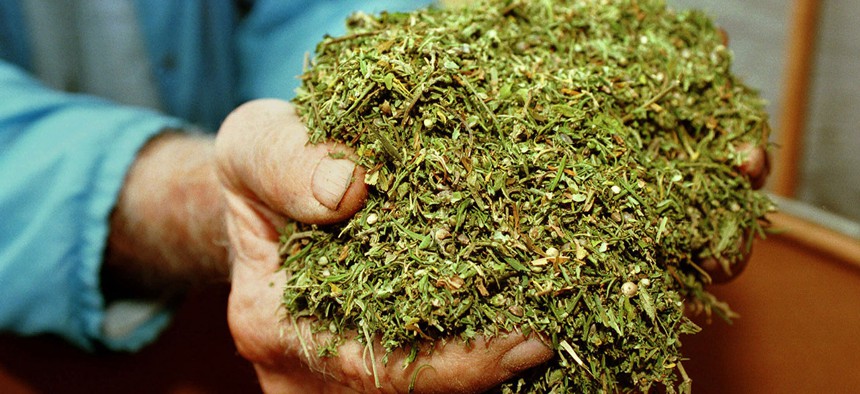The Government's Weed Is Terrible

A man holds marijuana cultivated at the University of Mississippi. Robert Jordan/AP file photo
… and that’s a big problem for medical marijuana research.
For years, researchers have been complaining: This is some schwag.
Since marijuana is still illegal under federal law, scientists who want to study the drug in their labs have to get it from a government-licensed facility at the University of Mississippi. Such has been the arrangement for decades. And in that time, the weed you can buy on the street and now in legal dispensaries has become way stronger.
This is a longstanding problem. A new paper out in Scientific Reports finally puts some numbers on exactly how bad it is.
When it comes to THC, the chemical that gets you high in marijuana, the government-grown variety averaged around 5 percent. Strains from dispensaries in four cities—Denver, Oakland, Sacramento, and Seattle—averaged from 15 to 20 percent.
Levels of cannabidiol or CBD, a chemical in marijuana that doesn’t get you high but is increasingly considered medically important, also varied quite a bit. The government’s strains averaged out to 6 percent, while the dispensaries’ strains ranged from an average of 8 to 13 percent.
Do you want to study what happens when patients smoke weed with four times as much THC as what’s available in government-issued stuff? You’re probably out of luck. The authors conclude, “this mismatch between what the public is using and what is available to researchers limits scientific study on the potential harms or benefits.”
One caveat here is that the government and dispensary strains were tested in different labs, and different labs have different equipment. The dispensary strains were tested by Steep Hill Labs, a commercial cannabis testing company. The government data came from the government itself—partly because access to government strains is so restricted. Still, the differences are huge.
Occasionally, researchers have found ways to get around the limitations of government weed. Earlier this year, I wrote about a pain study at the Saint Francis Hospital and Medical Center in Hartford, Connecticut. Because the state had legalized medical marijuana, doctors could certify patients to get the drug at dispensaries—without the hospital itself handling any weed. James Feeney, the surgeon running the study, told me at the time, “The strains I have to select from are so pure and so potent that the stuff they get from the University of Mississippi pales in comparison.”
The University of Mississippi has been slowly growing and developing new strains to diversify their selection. Last year, the Drug Enforcement Administration even announced it was accepting applications for new cultivators for marijuana used in research. A STAT reporter found few takers at the time, though. The weak stuff is not going away anytime soon.





